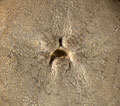Cotteau (1887, pl 20, fig. 7) showed a tetrabasal apical system in his C. lesteli. However, Kier, (1962, p. 188) stated that the apical system of the type species is definitely monobasal (which we confirm), and suspected that Cotteau\'s artist may have made an error.
Lambert & Thiery (1909-1925) considered Lamarck\'s Galerites ovatus a nomen nudum and used Goldfuss\'s Clypeaster leskei instead. Kier (1962) noted that Lamarck includes a description of ovatus, and so this name does not represent a nomen nudum and is the oldest available.
Clypeolampas differs from Vologesia in that it has adoral interambulacral plates elevated to form mound-like projecting bourrelets. It differs from Hungaresia in having much more complex phyllodes with many intermediate pores (Smith & Jeffery, 2000).
P. M. Kier. 1962. Revision of the cassiduloid echinoids. Smithsonian Miscellaneous Collections, 144 (3) 262 pp.
J. Lambert & P. Thiery. 1909-1925. Essai de nomenclature raisonnee des echinides. Libraire Septime Ferriere, Chaumont, 607 pp., 15 pls.
Pomel, A. 1869. Revue des échinoderms et de leur classification pour servir d’introduction à l’étude des fossiles, 67 pp. Deyrolle, Paris.
A. B. Smith & C. H. Jeffery. 2000. Maastrichtian and Paleocene echinoids: a key to world faunas. Special Papers in Palaeontology 63, 406 pp.




